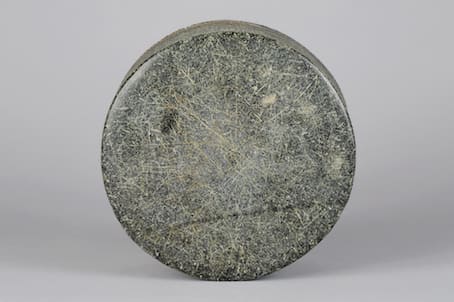Bactria-Margiana schist cosmetic vessel
Schist
CB.2961
Further images
The category of cosmetic palettes has been up to now mostly become related to a number of archaeological vessels, originally used in predynastic Egypt to grind and apply natural ingredients...
The category of cosmetic palettes has been up to now mostly become related to a number of archaeological vessels, originally used in predynastic Egypt to grind and apply natural ingredients as facial or body cosmetics. Such artefacts were mainly decorative, and after the late 4th millennium BC appear to have lost this function and to became commemorative, ornamental, and possibly ceremonial. Egyptian cosmetic palettes were made almost exclusively out of siltstone, originating from the quarries in the Wadi Hammamat, a major mining region and trade route east from the Nile Valley. Many of the palettes were found at Hierakonpolis, the religious and political capital of the Upper Egypt and a major centre of power during the pre-dynastic period. After the unification of the country, the palettes ceased to be included in tomb assemblages. Stone palettes, known also as cosmetic palettes or toilet trays, are also a specific category of stone recipients, usually round in shape, commonly found in the geographical areas of Bactria and Gandhara, and often decorated with figural scenes of a mythological context. A number of these artefacts has been attributed to the Indo-Greek period between the 2nd and 1st century BC, whereas another group is considered to be of later production, dating around the 1st century AD, during the period of the Indo-Parthian Kingdom. There is no archaeologically sustainable evidence contributing to the fact that stone palettes continued to be crafted after the 1st century AD. Many have been found at the archaeological site of Sirkap, a Greco-Bactrian city situated in the bank opposite today's city of Taxila, in the Punjab Province of Pakistan. Several scholars have suggested that such trays were used to mix cosmetic products in powder.
The Ancient Orient Museum, a small private museum in Tokyo, specializing in Asian artefacts, was able to chemically analyse the remains of substances adhering to a number of stone palettes in their collection, which turned out to be colored cosmetic powders akin to blush.
A frieze discovered by the Italian Archaeological Mission to the site of the Butkara Stupa, in the area of the Swat river, in Pakistan, shows a woman using a mirror as she puts her fingers into one of these stone palettes. These stone palettes provide an interesting instance of Hellenistic art in the northwestern Indian subcontinent as they happen to be completely disconnected from the Buddhist narrative to which works are usually associated in the Greco-Buddhist art of Gandhara.
The Ancient Orient Museum, a small private museum in Tokyo, specializing in Asian artefacts, was able to chemically analyse the remains of substances adhering to a number of stone palettes in their collection, which turned out to be colored cosmetic powders akin to blush.
A frieze discovered by the Italian Archaeological Mission to the site of the Butkara Stupa, in the area of the Swat river, in Pakistan, shows a woman using a mirror as she puts her fingers into one of these stone palettes. These stone palettes provide an interesting instance of Hellenistic art in the northwestern Indian subcontinent as they happen to be completely disconnected from the Buddhist narrative to which works are usually associated in the Greco-Buddhist art of Gandhara.









